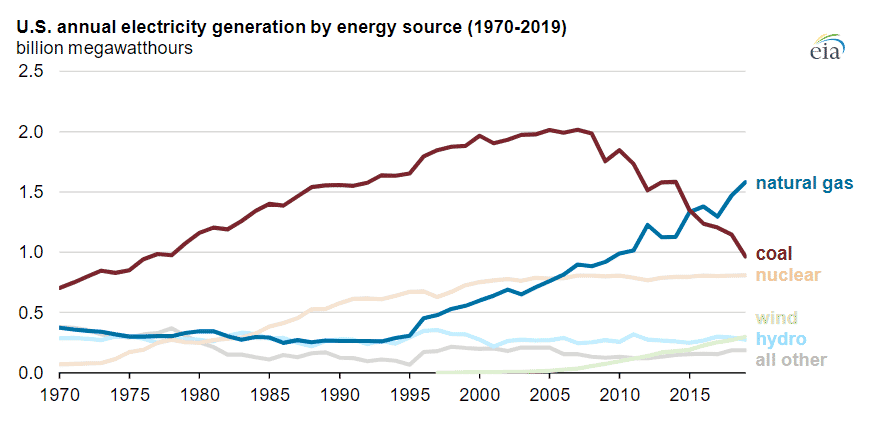U.S. Coal-Fired Power Generation Dropped to Four-Decade Low in 2019: EIA

U.S. coal-fired generation dropped by 16 percent last year, reaching 966,000 gigawatt-hours, the lowest since 1976, according to a May 11 report from the U.S. Energy Information Administration. The decrease was largely driven by increased output from natural gas-fired plants and wind generation facilities. Lower power demand in 2019 also contributed to the fall in coal generation.
Gas-fired generation hit a record high of nearly 1.6 million GWh in 2019, up 8 percent from 2018, the agency said. Wind generation also set a new record last year, exceeding 300,000 GWh, up 10 percent from 2018.
After peaking at 318 gigawatts in 2011, coal-fired generation capacity has been declining and reached 229 gigawatts by the end of 2019. Many plants have retired, while some switched to other fuels, and few new plants came online. Moreover, the utilization or rate of operation of the U.S. coal fleet decreased from 67 percent in 2010 to 48 percent in 2019. Utilization rates fell amid a growth in generation from competing sources. Notably, natural gas combined-cycle turbine plants operated at 57 percent of capacity last year compared to less than 50 percent capacity for coal.
Coal-fired generation dropped by more than 18 percent each in the Southeast, East North Central, and West South Central regions. The glut in low-priced natural gas has been the main factor behind the fall in coal-fired power. Further, highly efficient gas plants have lowered the amount of time a coal plant is called on to dispatch power, thereby reducing average coal plant utilization rates and causing early retirement.
Despite the lower cost of coal at U.S. power plants, its delivered cost must be at least 30 percent lower to make up for the differences in efficiency when compared to a natural gas-fired plant. Coal plants are also challenged by the costs for emission control and other operations.
EnerKnol Pulses like this one are powered by the EnerKnol Platform—the first comprehensive database for real-time energy policy tracking. Sign up for a free trial below for access to key regulatory data and deep industry insights across the energy spectrum.
ACCESS FREE TRIAL